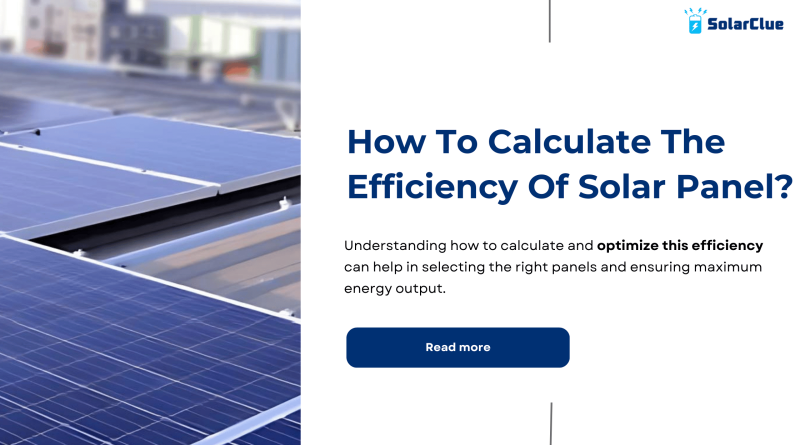How To Calculate The Efficiency Of Solar Panel?
Solar panel efficiency is a critical factor in the performance and cost-effectiveness of solar energy systems. Understanding how to calculate and optimize this efficiency can help in selecting the right panels and ensuring maximum energy output. In this blog, we’ll look into How To Calculate The Efficiency Of Solar Panel?
Table of Contents
Understanding Efficiency Ratings and Labels
Solar panel efficiency is defined as the ratio of the electrical output of a solar panel to the incident energy in the form of sunlight. This efficiency is typically represented as a percentage and indicates how well the panel converts sunlight into usable electricity.
Efficiency ratings and labels are provided by manufacturers based on standardized tests, which help consumers compare different panels. Higher efficiency means more power generation in a given area, making it crucial for space-constrained installations.
Factors Affecting Solar Panel Efficiency
Several factors can impact the efficiency of solar panels, including:
1. Temperature: Higher temperatures generally reduce efficiency.
2. Angle and Orientation: Panels should be oriented and angled to maximize sunlight exposure.
3. Shading: Partial shading can significantly reduce efficiency.
4. Dust and Dirt Accumulation: Regular cleaning is essential to maintain efficiency.
5. Panel Age and Degradation: Efficiency decreases over time due to wear and tear.
Calculating Efficiency Under Standard Test Conditions (STC)
Standard Test Conditions (STC) provide a baseline for comparing solar panels. STC typically includes:
- Solar Irradiance: 1000 W/m²
- Cell Temperature: 25°C
- Air Mass: 1.5
To calculate efficiency under STC:
1. Measure Solar Irradiance (E): The amount of sunlight energy received per unit area, measured in watts per square meter (W/m²).
2. Measure Panel Output (P): The electrical power output of the panel, measured in watts (W).
3. Calculate Panel Area (A): The surface area of the panel, measured in square meters (m²).

Real-World Efficiency Considerations
In real-world conditions, factors like temperature fluctuations, shading, and panel orientation affect efficiency. To estimate real-world efficiency:
1. Measure the actual solar irradiance at the location.
2. Measure the actual power output of the panel.
3. Use the same formula to calculate efficiency.

Improving Solar Panel Efficiency Through Technology Advancements
Recent advancements in solar technology have led to significant improvements in efficiency:
1. Bifacial Solar Panels: Capture sunlight from both sides, increasing overall output.
2. Multi-Junction Solar Cells: Use multiple layers to capture different wavelengths of light.
3. PERC Technology: Enhances efficiency by improving light capture and reducing electron recombination.
Example: A PERC solar panel with an STC efficiency of 20% might achieve 22% with real-world enhancements.
Efficiency Calculation Example
| Parameter | Example Value (STC) | Example Value (Real-World) |
|---|---|---|
| Solar Irradiance (E) | 1000 W/m² | 800 W/m² |
| Panel Output (P) | 300 W | 250 W |
| Panel Area (A) | 1.6 m² | 1.6 m² |
| Efficiency (η) Calculation | (300/1000*1.6) * 100 | (250/800*1.6) * 100 |
The Relationship Between Efficiency and System Performance
Higher efficiency panels produce more electricity per square meter, reducing the number of panels needed for a given energy output. This can lead to cost savings in installation and maintenance.
Example scenario:
1. Low-efficiency panel (15%): Needs 20 panels to produce 6 kW.
2. High-efficiency panel (20%): Needs 15 panels to produce 6 kW.
This difference can impact the overall system cost and space requirements.
Conclusion
Understanding and calculating solar panel efficiency is essential for optimizing solar energy systems. By considering factors like STC, real-world conditions, and technological advancements, you can make informed decisions to maximize performance and cost-effectiveness.
Here at SolarClue®, we offer a smart, practical, and “beautiful” solution. You will be answered for all the questions related to Solar.
We provide all kinds of brands that are the Best Solar panels in India.
If you are the one who is planning for the solar power system. Don’t hesitate to contact our team!
Looking forward to empowering you with solar energy, just like hundreds of our other clients!
FAQs
1. What is solar panel efficiency?
It is the ratio of the electrical output of a solar panel to the incident solar energy, expressed as a percentage.
2. How do temperature and shading affect efficiency?
Higher temperatures generally reduce efficiency, and shading can cause significant power loss.
3. What are Standard Test Conditions (STC)?
STC are a set of standardized conditions used to rate solar panel performance, including 1000 W/m² solar irradiance and 25°C cell temperature.
4. Can real-world efficiency differ from STC efficiency?
Yes, real-world conditions often result in lower efficiency due to environmental factors.
5. How can I improve the efficiency of my solar panels?
Use advanced technologies like PERC and bifacial panels, and ensure optimal installation and regular maintenance.




